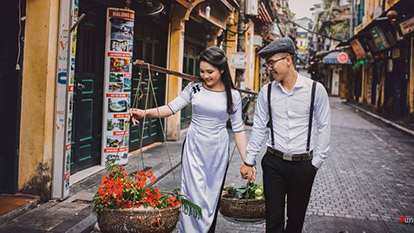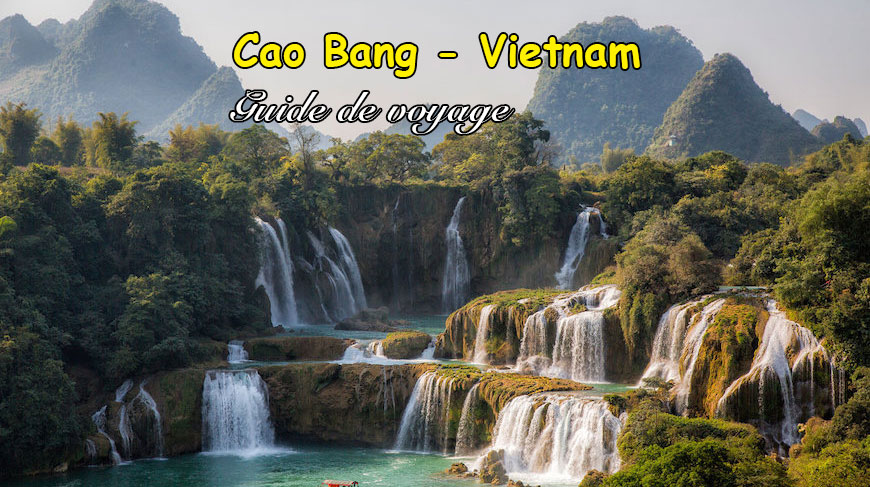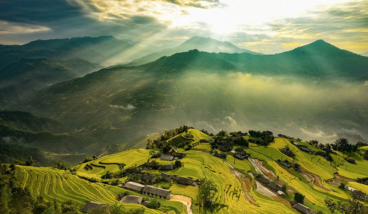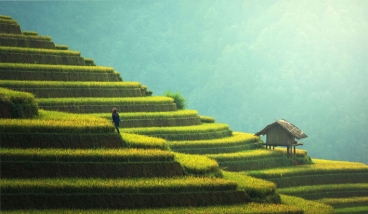Vietnam Economy & Currency
13/04/2019 1.503 Views
The economy of Vietnam is a socialist-oriented market economy, which is the 45th-largest in the world as measured by nominal gross domestic product (GDP) and 33rd-largest in the world as measured by purchasing power parity (PPP). Vietnam is a member of Asia-Pacific Economic Cooperation, Association of Southeast Asian Nations and the World Trade Organization.
Vietnam Economy
- Historically, Vietnam has been an agricultural civilization based on wet rice cultivating. The Vietnam War destroyed much of the economy of Vietnam. Upon taking power, the Government created a planned economy for the nation. Collectivization of farms, factories and economic capital was implemented, and millions of people were put to work in government programs. For a decade, united Vietnam's economy was plagued with inefficiency and corruption in state programs, poor quality and underproduction and restrictions on economic activities and trade. It also suffered from the trade embargo from the United States and most of Europe after the Vietnam War. Subsequently, the trade partners of the Communist blocs began to erode.
- In 1986, the Sixth Party Congress introduced significant economic reforms with market economy elements as part of a broad economic reform package called "đổi mới" (Renovation), resulting in a Socialist-oriented market economy. Private ownership was encouraged in industries, commerce and agriculture.
- Vietnam achieved around 8% annual GDP growth from 1990 to 1997 and continued at around 7% from 2000 to 2005, making it the world's second-fastest growing economy. Simultaneously, foreign investment grew threefold and domestic savings quintupled.
- Manufacturing, information technology and high-tech industries form a large and fast-growing part of the national economy. Vietnam is a relative newcomer to the oil business, but today it is the third-largest oil producer in Southeast Asia with output of 400,000 barrels per day (64,000 m³/d). Vietnam is one of Asia's most open economies: two-way trade is around 160% of GDP, more than twice the ratio for China and over four times India's.
- Vietnam is still a relatively poor country with an annual GDP of US$280.2 billion at purchasing power parity (2006 estimate).[30] This translates to a purchasing power of about US$3,300 per capita (or US$726 per capita at the market exchange rate). Inflation rate was estimated at 7.5% per year in 2006. Deep poverty, defined as a percent of the population living under $1 per day, has declined significantly and is now smaller than that of China, India, and the Philippines.
- As a result of several land reform measures, Vietnam is now the largest producer of cashew nuts with a one-third global share and second largest rice exporter in the world after Thailand. Vietnam has the highest percent of land use for permanent crops, 6.93%, of any nation in the Greater Mekong Subregion. Besides rice, key exports are coffee, tea, rubber, and fishery products.
- However, agriculture's share of economic output has declined, falling as a share of GDP from 42% in 1989 to 20% in 2006, as production in other sectors of the economy has risen. According to the CIA World Fact Book, the unemployment rate in Vietnam is 4.3%.[32] Among other steps taken in the process of transitioning to a market economy, Vietnam in July 2006 updated its intellectual property legislation to comply with TRIPS.
- Vietnam was accepted into the WTO on November 7, 2006. Vietnam's chief trading partners include China, Japan, Australia, ASEAN countries, the U.S. and Western European countries.
Vietnamese Currency - Vietnam Dong (VND)
- The currency of Vietnam is "Dong" (abbreviated "d" or VND). Bank notes are: 100d , 200d and 500d (too small value - rarely used); 1,000d; 2,000d; 5,000d; 10,000d, 20,000d, 50,000d; 100,000d, 200,000d and 500,000d. Coins have recently come into circulation but not widely been accepted due to inconvenience, including: 200d; 500d; 1,000d; 2,000d and 5,000d.
- US dollar is widely accepted while most major currencies can be exchanged at leading banks in Vietnam (Vietcombank, ANZ, ACB, VIB Bank…) or some hotels and jewelry shops. The official rate of exchange is approximately VND17,500 to US$1. With the relatively low value of Dong, you are recommended to carry US dollar in small notes; it will help you to change easily.
- Euros was widely accepted in Vietnam. 1EUR = VND25,000 (August 2009).
- ATMs can be a choice as it’s very popular in most of tourist destinations now. Vietcombank (VCB) has the best network in the country. Withdrawals are issued in Dong (50,000d; 100,000d; 200,000d; 500,000d only). There is a limit of 2,000,000d (about US$115) for each withdrawal and a daily limit of 20,000,000d. Fee is 50,000d (US$3) each time.
- Visa, MasterCard and JCB cards are widely accepted. Some merchants also accept Amex. A 4%-commission charge on every transaction (3% for other cards) is pretty common, due to bank’s policy. Getting cash in advance from cards is possible at Vietcombank and some foreign banks in Hanoi and Ho Chi Minh City.
- Travellers Cheques are accepted at most of hotels, restaurants but in major cities. If you only have travellers cheques, stock up on US dollars at a bank, which usually charge anywhere from 1.25% to 3% commission to change them into cash. VCB charges no commission to changing travellers cheques for Dong. If your travellers cheques are in currencies other than US dollars, they may be useless beyond the major cities. Hefty commissions are the norm it they can be exchanged at all.
ONLY WITH US : 100 % MONEY BACK GUARANTEE within 10 days from the date of booking if not satisfied.
For further information, or simply a free quote, please contact us at any time via our email: info@galatourist.com, our experienced consultants will reply to you within 48 hours.Sincerely yours & see you soon!
GALATOURIST since 2005.
Related Articles
Coronavirus situation by traveller in Vietnam on February 4, 2020
Coronaviruses are a large family of viruses, which cause illnesses ranging from a simple cold (some seasonal viruses are coronaviruses) to more severe conditions such as MERS or SARS. The virus identified in Wuhan in December 2019 is a novel coronavirus. It was named 2019-nCoV.
Top 29 best places to visit in Hanoi Vietnam
As the capital of Vietnam, Hanoi still retains its leisurely pace in a quiet atmosphere compared to the more bustling Ho Chi Minh City. However, Hanoi deserves to be the capital of Vietnam thanks to its typical culture accumulated along the passage of time which defines best what Vietnam is. The article will show you 29 best places to visit in Hanoi for your choices.
Top 6 best homestays in Tha Village Ha Giang
Tucked away in the serene hills just 3–5 kilometers from Ha Giang city, Tha Village is a peaceful little world in which nature and culture closely intertwine. Bounded by vast mountains, golden rice fields and meandering streams, this Tay ethnic village will allow you to have a genuinely Northern Vietnamese countryside experience. Come harvest time, the landscape transforms into a golden wonderland that has postcard - worthy views. Visitors are warmly welcomed by the friendly Tay people and can observe or join in daily activities such as traditional cooking, weaving, or folk singing. Looking for where to stay in Tha Village ? With cozy homestays throughout, there are top 6 best homestays in Tha Village that not only offer comfort but the chance to live like a local. This is much more than a place to stay; it is an authentic cultural experience far off the beaten track.
Complete Travel Guide to Cao Bang Vietnam
Are you planning to travel to Cao Bang, a land blessed by nature with the breathtaking beauty of majestic mountains, picturesque landscapes, and fresh, pure air? Here is our complete travel guide to Cao Bang, along with practical tips to help you better prepare for your visit to this wild and unspoiled region in the northwest of Vietnam.
Explore Hoang Su Phi rice terraced fields - Vietnam iconic landscape
Terraced rice fields are one of the breathtaking wonders shaped by both nature and human hands — a truly unique form of cultivation that can only be found in Vietnam. Among the most iconic landscapes, the Vietnam terraced rice fields in Hoang Su Phi are a top destination, especially during the stunning golden rice season. The Hoang Su Phi rice terraced fields, with their layered golden waves cascading down the mountains, attract thousands of local and international visitors each year. However, reaching and exploring these scenic rice terraces can be quite challenging for those who are inexperienced or unprepared. To help you make the most of your trip, we’ve compiled some practical travel tips for Hoang Su Phi that will guide you through a smooth, safe, and unforgettable adventure in one of Vietnam’s most breathtaking rural regions.
Pu Luong Travel Guide Vietnam A to Z
Surrounded by lush forests, rolling hills, and cascading rice terraces, Pu Luong Vietnam invites you to reconnect with what truly matters. Whether you're seeking quiet contemplation, exciting adventures, or meaningful moments with friends and family, this destination has something for everyone. Our Pu Luong travel guide below will provide you with all the essential information, tips, and inspiration to plan a memorable trip this week. From scenic hikes and refreshing streams to cultural encounters with ethnic minorities, Pu Luong offers a magical blend of serenity and exploration.
Foodtour in Chinatown Saigon
When mentioning Saigon Chinatown, people will immediately think of Chinatown in the 5th District, where many architectural works of Assembly Halls and pagodas with ancient Chinese architecture are concentrated, and especially, this is also the place where many traditional Chinese restaurants can make your taste buds explode. From famous dishes such as dimsum, roast duck, duck braised noodles to Chinese sweet soup, egg tarts, Chinatown Ho Chi Minh brings a complete experience for tourists who love to explore East Asian culture.
Best season to visit Ben Tre Vietnam
When is the best time to travel to Ben Tre? Learn about Ben Tre’s climate characteristics and choose the ideal time to discover the charm of its rivers, fruit gardens, and vibrant folk festivals. We hope the article below will help you plan your Ben Tre trip according to your schedule and personal preferences!
Travel guide to Ba Be National Park Vietnam in Bac Kan province
Ba Be National Park in Bac Kan stands out with its limestone mountains, the largest freshwater lake in Vietnam, diverse ecosystems, and distinctive ethnic cultures. From boating and trekking to exploring caves and traditional villages, it is an ideal destination for those who love nature and want to experience unique local culture.
What to do in Ba Be Lake ? Best things to do in Ba Be Bac Kan
If you're looking for an unspoiled ecotourism destination where forests, mountains, rivers, and authentic local culture come together, then Ba Be Lake, a true "green jewel" nestled in the heart of Vietnam’s northeastern mountains – is a must-visit. Located in Ba Be National Park, Bac Kan province, this is the largest natural freshwater lake in Vietnam, promising unforgettable travel experiences.
Complete travel guide for Ba Be Lake in Bac Kan
Ba Be Lake is one of the most famous tourist destinations in Northeast Vietnam. This place draws visitors with its cool climate and spectacular natural landscapes nestled in the mountains and forests of Bac Kan. What to do in Ba Be? When to visit Ba Be Lake? Follow Galatourist to discover all the practical tips from A to Z to make the most of your trip to Ba Be and create unforgettable memories!
Admire the majestic but charming beauty of Dai Yem Waterfall in Moc Chau
Located in the heart of Moc Chau, Vietnam, Dai Yem Waterfall is a must-visit for nature lovers and adventure seekers alike. Known for its breathtaking beauty and tranquil surroundings, this hidden gem is the perfect escape from the bustling city life. If you're wondering what to do in Moc Chau, Vietnam, a trip to Dai Yem Waterfall should be at the top of your list. In this article, we'll explore the best ways to experience this natural wonder and share tips for making the most of your visit. Stay tuned to the Vietnam travel blog by Galatourist for more insights!
Testimonials
The following are the real customer reviews about GalaTourist by video clips, email & feedback form, etc... please check it out!

Ms. Francesca Tronconi & Mr Vizzolini Davide (2pax) from Spain
Ms. Francesca Tronconi & Mr Vizzolini Davide from Spain, taked a Tour in Vietnam on 8.2018

Mrs & Mr. DUPUIS (2pax) from United States
Mrs & Mr. DUPUIS from US taked a vacation of THAILAND & CAMBODIA & VIETNAM 14 days on 3.2018

Mr. Jeffrey Szymanski (2pax) from United States
They taked a trip of Vietnam and Cambodia 11 days on 3.2018

Mrs Rosemary McGuinness (2pax) from Australia
Taking a trip of Vietnam & Cambodia 14 days on 26th mars 2018

Mrs Elena Maria Sanchez (2pax) from Spain
Mrs Elena Maria Sanchez from Spain taked a trip in Vietnam on 1.2016

Group Marissa (4pax) from United States
Group Marissa 4pax from USA taked a Trip in Vietnam on 2.2016

Mr Jerzy (2pax) from Canada
Mr Jerzy from Canada have traveled in Vietnam on 3.2016

Mr Ricardo Velasco (8pax) from Argentina
Sr Ricardo Velasco 8pax - Argentina taked a trip to Vietnam Cambodia Thailand on 2016.


















